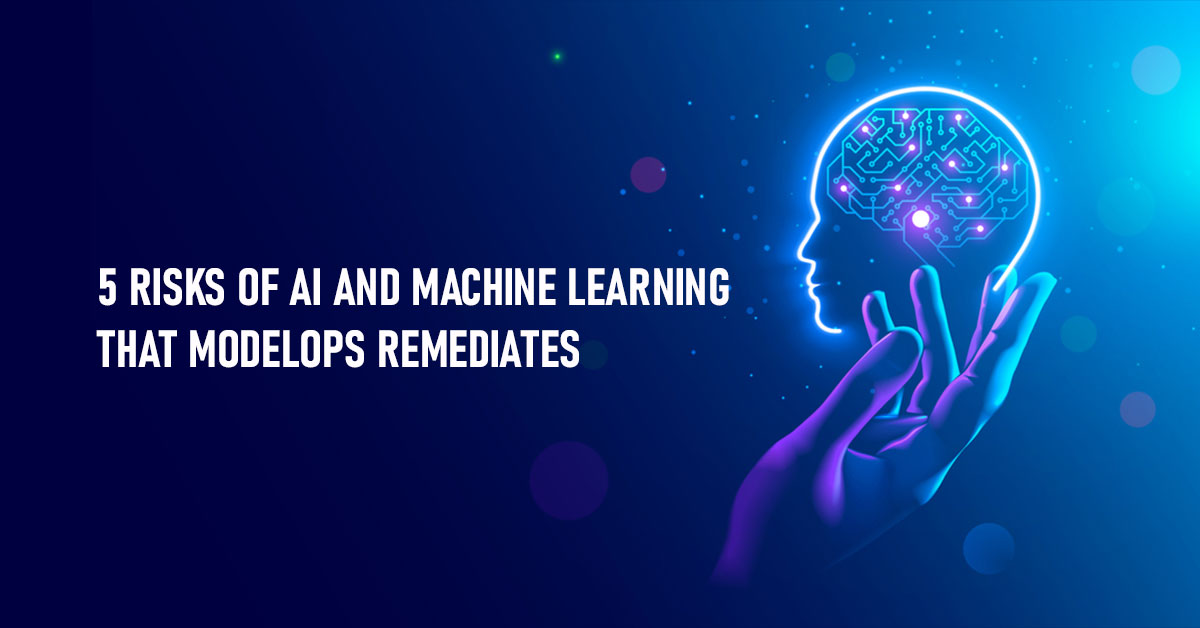5 risks of AI and machine learning that modelops remediates

Data Scientist
Deep learning and machine learning specialist, well-versed with experience in Cloud infrastructure, Block-chain technologies, and Big Data solutions.
December 04, 2022

The development, testing, deployment, and monitoring of machine learning models are all improved by Modelops. These pointers will enhance the effectiveness and usefulness of any ML initiatives by reducing model risk.
Consider a scenario where your company's data science teams have established business objectives for areas where analytics and machine learning models can influence the bottom line. They are now prepared to begin. Data sets have been labeled, machine learning tools have been chosen, and a procedure for creating machine learning models has been devised. Access to scalable cloud infrastructure is available to them. However, more than giving the group the go-ahead to develop machine learning models and introduce effective ones into production is required.
Not so quickly, caution some machine learning and artificial intelligence professionals who know that every innovation and production deployment carries dangers that need analysis and corrective action plans. They recommend starting the development and data science processes with risk management procedures. Innovation and risk management, according to John Wheeler, senior adviser of risk and technology for AuditBoard, are two sides of the same coin in the field of data science or any other similarly emphasized business activity.
Software developers need to take safety precautions and industry best practices into account to write code and send it into production, to use an analogy from creating apps. To mitigate risks, the majority of firms build observability requirements, shift left on devsecops procedures, and implement software development life cycles (SDLC). Additionally, by using these procedures, development teams can maintain and enhance their code once it is put into use.
Modelops, a collection of procedures for managing the life cycle of machine learning models, is the SDLC's equivalent in managing machine learning models. Modelops techniques cover the creation, testing, and deployment of machine learning models into production and the monitoring and improvement of ML models to ensure they produce the desired outcomes.
In this post, I concentrate on the potential issues related to modelops and the machine learning life cycle because risk management is a large category of potential problems and their treatment. Data privacy, data security, and other related risk management topics include data quality. Data scientists must also check training data for biases and take other significant ethical and responsible AI considerations into account.
Following are five troublesome areas that modelops approaches and technology can help to resolve based on my conversations with various experts.
1. Model development without a risk management plan.
More than 60% of AI enterprise leaders indicated that it is difficult to manage risk and regulatory compliance in the State of Modelops 2022 Report. In companies, partnering with risk management executives to design a plan that is in line with the modelops life cycle should be the first step because data scientists are not specialists in risk management.
According to Wheeler, "The purpose of innovation is to look for better ways to achieve the desired business objective. For data scientists, this frequently entails developing fresh data models to support improved judgment. Without risk management, nevertheless, that intended business result can be very expensive. Data scientists must recognize and minimize the risks of constructing trustworthy and credible data models while pursuing innovation.
Data scientists must recognize and reduce the risks inherent in the data as they work to innovate in order to provide trustworthy and valid data models.
ModelOp and Domino both provide white papers you may read to learn more about model risk management. Additionally, data scientists want to implement methods for data observability.
2. Adding redundant and domain-specific models will increase maintenance
Additionally, data science teams ought to establish guidelines for deciding which business issues to prioritize and how to generalize models that work across one or more business domains and areas. Data science teams require effective methods to train models in new business areas; they should avoid building and maintaining several models that address the same challenges.
Chief Solutions Officer at Mphasis Srikumar Ramanathan is aware of this issue and its implications. He notes that even when employing basic machine learning techniques, "the ML models are trained from scratch every time the domain changes."
This remedy is presented by Ramanathan. We may train the model for the new domains with less effort by employing incremental learning, in which we continuously extend the model using the input data.
A method for continually or on a predetermined cadence training models on new data is called incremental learning. Examples of incremental learning can be found in Matlab, Python River, Azure Cognitive Search, and AWS SageMaker.
3. Using more models than the data science staff can handle.
Beyond the procedures to retrain them or execute incremental learning, sustaining models is difficult. The constant inability of data science teams to revamp and redeploy their models poses an increasing but mostly ignored concern, according to Kjell Carlsson, head of data science strategy and evangelism at Domino Data Lab.
Data scientists can assess their model velocity in a manner akin to how devops teams track the cycle time for delivering and deploying products.
"Model velocity is typically much below what is needed, resulting in a developing backlog of poor models," Carlsson notes, describing the risk. A ticking time bomb is created as these models become more crucial and pervasive within organizations and as customer and market behavior change at an accelerating rate.
Could I call this problem "model debt"? The crucial first step in managing this risk is assessing model velocity and the effects of underperforming models on the business, as suggested by Carlsson.
Data science teams should think about centralizing a model catalogue or registry so that team members are aware of the available types of models, where they are in the ML model life cycle, and who is in charge of maintaining them. Data catalogue platforms, ML development tools, and both MLops and modelops technologies have model catalogue and registry features.
4. Getting slowed down by inefficient review panels
Let's assume that the data science team adhered to the organization's standards and recommended procedures for data governance and models. Are they prepared to use a model now?
Review boards may be a good idea for risk management businesses to set up to ensure data science teams take all acceptable risks into account. When data science teams are just beginning to put machine learning models into production and employ risk management methods, risk evaluations may be reasonable. What should you do if a review board becomes a bottleneck and when is a review board necessary?
An alternative strategy is provided by Chris Luiz, director of solutions and success at Monitaur. "A mix of excellent governance principles, software tools that complement the data science life cycle, and strong stakeholder alignment across the governance process is a better answer than a top-down, post-hoc, and draconian executive review board," says one expert.
Luiz offers several suggestions on modelops technologies. The tooling "must perfectly match the data science life cycle, preserve (and ideally accelerate) the speed of innovation, meet stakeholder needs, and enable a self-service experience for non-technical stakeholders," he says.
Platforms from Datatron, Domino, Fiddler, MathWorks, ModelOp, Monitaur, RapidMiner, SAS, and TIBCO Software are a few examples of modelops solutions with risk management features.
5. Failing to keep an eye out for operational problems and data drift in models.
Will anyone notice if a tree falls in the forest? We are aware that the code needs to be updated to accommodate upgrades to the infrastructure, libraries, and frameworks. Do monitors and trending reports warn data science teams when an ML model underperforms?
According to Hillary Ashton, executive vice president, and chief product officer at Teradata, "every AI/ML model put into production is guaranteed to degrade over time due to the changing data of dynamic business environments."
"Once in production, data scientists can utilize modelops to automatically detect when models start to decline (reactive via concept drift)," suggests Ashton (proactive via data drift and data quality drift). They may be notified to look into it and take appropriate action, such as retraining (to update the model), retiring (requiring extensive remodeling), or ignoring (false alarm). Remedial action in the case of retraining can be totally automated.
Conclusion
What you ought to take away from this analysis is that data scientist teams ought to specify their modelops life cycle and create a risk management approach for the crucial phases.
To consolidate a model catalogue, increase model velocity, and lessen the effects of data drift, data science teams should collaborate with their compliance and risk officers and employ tools and automation.













